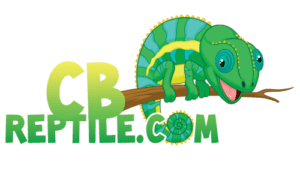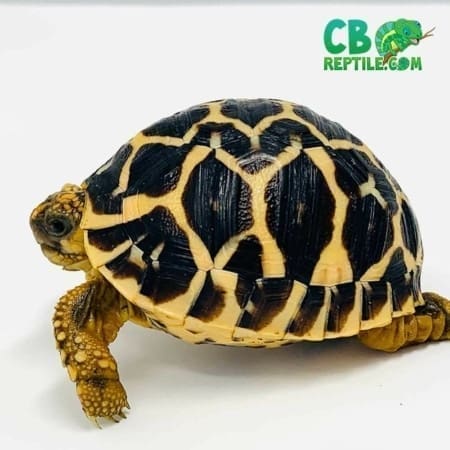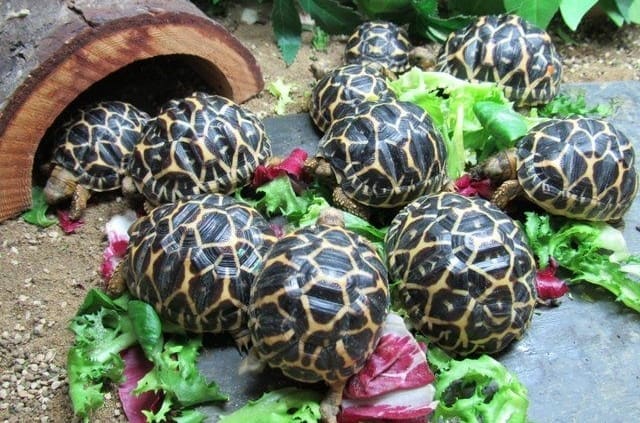
Indian Star Tortoise for Sale
Interested in buying an indian star tortoise for sale? At CbReptile we have one of the largest selections of captive bred tortoises for sale online.
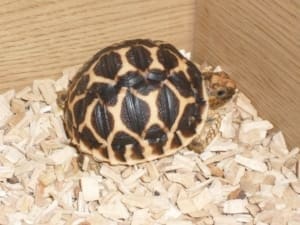
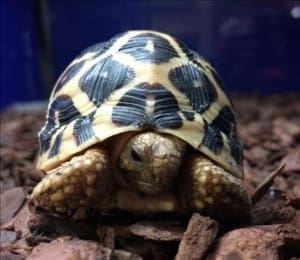
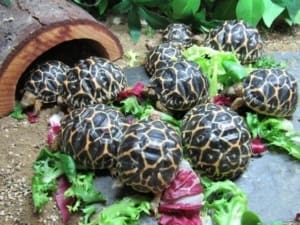
Enclosure
Tortoises are generally happiest when kept in an appropriately sized enclosure. For their first few years, youngsters can be kept in smaller enclosures, with larger enclosures being provided as they grow.
These animals are from humid environments, so although in some cases it is possible to use a tortoise table enclosure, wooden vivariums with sliding glass doors are best, as the humidity needs to be managed in the enclosure.
The tortoise should not be able to see out through any glass in front of them. If they can see out, it makes them want to get out, which can be stressful. They cannot see glass, and may be injured by trying to climb through it. If needed, a visual barrier can be painted on the outside of any glass with non-toxic (eg. water-based acrylic) paint. This barrier should be taller than the length of the tortoise’s shell. All-glass enclosures are difficult to heat and light correctly for a tortoise, and would still need to be modified to add visual barriers. They should not be used for tortoises.
An enclosure 90 cm (3 feet) long and 38 cm (15 inches) wide can serve one indian star tortoise for sale for their first 2 to 3 years, or an enclosure 120 cm (4 feet) long and 60 cm (2 feet) wide can serve them for their first 4 to 5 years, after which they can be given their adult enclosure. The height is irrelevant as long as it can be heated and lit correctly, but it is normally best to use a terrestrial vivarium that is about 45 cm (18 inches) high. Examples include the Vivexotic Repti-Home and Viva+ Terrestrial Large Deep vivariums.
The enclosure needs to have an unscented substrate (bedding) on the bottom that is designed for retaining humidity, can offer the tortoise something to grip onto, can allow them to dig shallow nests, and is safe if accidentally eaten. If the tortoise lives on a slippery surface, their muscles and joints will not form correctly, and they will be unable to get up if they fall on their backs. Substrate should be as deep as the length of the tortoise’s legs, or a little deeper. Fine grade bark chips can work well, but compacted coconut fibre is another option. Freeze-dried grass (often marketed as Readigrass) is another good option, allowing the tortoise to eat it as well as live on it, though it needs to be changed more frequently to remove any mouldy patches, particularly under the water and food bowls. Some owners like to use more than one type of substrate (such as tortoise pellets, made from straw) at different locations in the enclosure, but note that the humidity-retaining substrate should be used under or near the basking lamp, and tortoise pellets degrade rapidly when exposed to moisture. Cypress mulch can contain sharp pieces and may cause injuries if these pieces are too large or sharp. Aspen, hemp, lignocell, beech and other wood chips are not suitable. Sand is especially dangerous, as tortoises drag their food onto the floor to eat it, and are prone to eating the substrate at the same time, and sand can cause severe internal blockages that may result in death. Although these tortoises can sometimes be found near sandy areas, they do not naturally eat on sand – the plants they eat grow above them. Sand also has a severe dehydrating effect. Soil is a little better, but still causes problems when eaten, does not absorb odours, and creates dust which is inhaled by the tortoise and covers them in a layer of dirt.
During the daytime, a basking lamp heats one end of the enclosure to over 30 to 35°C (86 to 95°F), leaving the other end at about room temperature. This creates a heat gradient with lots of choices of temperature, allowing the tortoise to warm up when it needs to, and cool down when it needs to. The tortoise chooses the temperature it wants. The bulb should be mounted so that it hangs above the tortoise, about half way between the front and back of the enclosure, and a similar distance from the end wall. Night time temperatures in nature are higher than a typical British house, and some source of night time heat is required. The intention is to have a warm part of the enclosure with a temperature of at least 24°C at night. This can be provided by a low power heat mat stuck to the ceiling or wall (not the floor) at the warm end of the enclosure, and ideally this is controlled with a mat thermostat so that it does not change throughout the year. Heat in nature comes from the sun, and tortoises are not adapted to using heat sources below them – they may burn on a heat mat if it is placed below them. Examples include the Habistat, ProRep or Lucky Reptile 4 Watt, 7 Watt or 11 Watt heat mats. Alternatively, a lower powered red basking lamp (which tortoises can see, but not as well as white light) can be used at night, positioned next to the daytime basking lamp. There are other ways to heat the enclosure, such as ceramic heaters, but the daytime basking lamp (and night time heat mat) is the best approach, as the tortoises are attracted to the light when they want to warm up, and the UVA (not UVB) that it gives off may improve their overall happiness.
Feeding
Indian star tortoises are adapted to their natural diet of various leafy weeds, flowers and grasses.
Every day, offer the tortoise fresh salad; loosely piled to the size of their shell. Start by using a good mix of fancy Mediterranean lettuces. Avoid iceberg/gem/round lettuce (which does not contain sufficient nutrition, and can cause diarrhoea) and spinach/cabbage/broccoli (which can cause bone/shell problems, and kidney stones). Many owners rely on Florette Classic Crispy, available all year in most supermarkets, or lamb’s lettuce, which is very healthy. Give a variety of different leaves. Once per month or fortnight, offer Curly Kale or Spring Green cabbage (the only cabbages that may be used in this way). Indian star tortoises should not be fed fruit, vegetables, or some herbs – they may like the taste, but these can cause serious health problems. As they get older, add increasing amounts of fresh grass (they prefer the softer leaves, but can move on to rougher varieties as they grow) or moistened timothy hay into their salad mix, up to about 20% of the total mix for an adult. It helps to put some on top of the salad with youngsters, so that they eat it by mistake, and learn to like it. Exercise can be encouraged, particularly in adult tortoises, by feeding small amounts throughout the day (adding up to the correct amount). The tortoise will then walk around between feedings, foraging for food – a natural behaviour.
An Indian star tortoise for sale must be given calcium and vitamin supplements several days per week, and it is best if that includes supplemental levels of vitamin D3. The calcium/vitamin dust is sprinkled lightly onto the salad (like salt on chips). In theory, adults (but not egg-laying females) can have it a little less often, but still should have some a couple of times a week at least.
Artificial, pelleted tortoise diets are available (typically formulated for Mediterranean or African tortoises, not Indian stars), which are moistened before serving to the tortoise. These should be considered a supplemental diet only – fresh food is much more important. However, it can help to feed these pelleted diets to a tortoise instead of their regular food once per fortnight or month, in order to train the tortoise to eat them. When the tortoise needs medicating (eg. for worming), liquid medicines can be soaked into the pelleted food and the tortoise will eat them.
We breed over 22 species of tortoise for sale including Red Foot Tortoises for sale, yellow foot tortoises for sale, leopard tortoises for sale, sulcata tortoises for sale, hermann’s tortoise for sale, indian star tortoises for sale, burmese star tortoises for sale, Sri lankan tortoises for sale, Greek tortoises for sale, Marginated tortoises for sale, Russian Tortoises for sale, aldabra tortoises for sale, Burmese mountain tortoises for sale, and many other species of baby and adult tortoises for sale online.
Tortoise for sale online from CB Reptile
At CBReptile.com, we specialize in all types of tortoise for sale, baby turtles for sale, adult tortoises for sale online as well as baby tortoises for sale. We breed here on site and work with captive bred tortoises for sale online. If you are looking for a tortoise for sale online, you have come to the right tortoise breeder.
Our tortoise farm is the best of any of the tortoise farms in the country as we work with over 25 species of captive bred reptiles for sale including turtles for sale online as well. Our sister site, tortoise town also offers tortoise for sale and tortoises for sale online, including sulcata tortoise for sale, leopard tortoise for sale, russian tortoise for sale and other captive-bred species of box turtles for sale and turtles for sale online.
Baby tortoises for sale
Some other species of pet tortoise for sale include the Sulcata tortoise, the Russian tortoise, Egyptian tortoise, Hermann’s tortoise. Other species of large tortoise for sale or giant tortoise for sale include Aldabra tortoise, Sulcata tortoises, Leopard tortoise, giant leopard tortoise.
Some medium-sized tortoises for sale include red foot tortoise, yellow foot tortoise, cherry head tortoise, Burmese star tortoise, and Sri Lankan Star tortoise. Other small tortoise includes the Indian star tortoise, western Hermann’s tortoise, and greek tortoise to name a few.
Reptiles for sale online
We are not only leopard gecko breeders! We are also proud to be crested gecko breeders as well as gargoyle gecko breeders! Be sure to checkout all of our leopard gecko for sale, as well as our baby leopard geckos for sale, crested gecko for sale, gargoyle gecko for sale as well as our panther chameleons for sale and iguanas for sale. We also offer ball python for sale, baby ball pythons for sale, bearded dragon for sale, tegu for sale, blue tongue skink for sale and more!
- Display 15 Products per page
